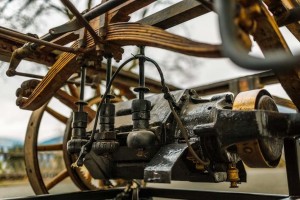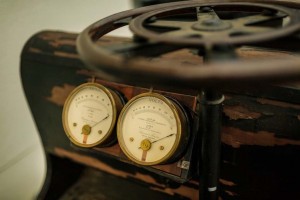It wasn’t your classic “barn find.” In the case of the rare P1, it was found stuffed in the back of an old Austrian warehouse – since 1902.
Officially known as the Egger-Lohner electric vehicle, C.2 Phaeton, it’s the first car ever designed by the legendary Ferdinand Porsche. And it was one of several electric vehicles the automotive pioneer – later known for his groundbreaking sports cars – developed in his early years.
The classic, newly restored after 115 years – more than 111 of them in storage – is getting its rightful place of honor at the Porsche Museum in Stuttgart this week as part of the gallery’s fifth anniversary.
The C.2. Phaeton was developed by the then 22-year-old Ferdinand Porsche, a promising young engineer who had come to Vienna to get some formal training from Jacob Lohner, an early automotive manufacturer. At the time, gasoline was a rare commodity and the industry’s pioneers were experimenting with all sorts of alternatives including steam and batteries.
(Porsche brings new 911 Targa to Detroit Auto Show. Click Here for a closer look.)
Porsche’s first try was little more than a crude carriage powered by an electric motor. The entire vehicle weighed in at 2,977 pounds – which included a 287-pound motor and 1,103 pounds of batteries.
That was enough to give the Egger-Lohner a range of 49 miles, its 5-horsepower motor allowing it to hit a top speed of 21 mph, though it was designed to cruise at something closer to 15 mph.
After a year of street testing, the P1 got its first serious challenge in September 1899 when it was shipped to the international motor vehicle exhibition in Berlin to compete in an all-electric vehicle race. Porsche’s Phaeton completed the challenge – which called for carrying three passengers a distance of 24 miles – 18 minutes ahead of the nearest competitor, half of whom failed to complete the race.
The car got its nickname, incidentally, because Ferdinand Porsche engraved “P1,” meaning Porsche car number one, on all key parts.
The C.2. Phaeton was far from the only time Porsche worked with electric propulsion. In fact, the Stuttgart museum already has a version of the Lohner-Porsche Electromobile, often known as the Mixte Hybrid, which is generally credited with being the world’s first plug-in hybrid. Produced between 1900 and 1905, the Mixte could be run solely on battery power or a combination of gas and electric.
And what’s particularly significant is that it used wheel-mounted, or hub, motors. That’s a concept that a number of manufacturers are beginning to experiment with again today. That includes Porsche Cars parent Volkswagen AG which recently announced plans to develop a hub motor-based car for the Chinese market.
(For more on VW’s hub motor project, Click Here.)
Ferdinand Porsche quickly became one of the most respected engineers in the early automotive world, going on to launch his eponymous car company in 1948. It was acquired by Volkswagen a little over a year ago after a complex battle between the two German makers.
Today, Porsche Cars is rolling out some of its own battery-based vehicles, including a plug-in version of the Panamera as well as the 918 Spyder hybrid supercar.




Cool car from a automotive genius.